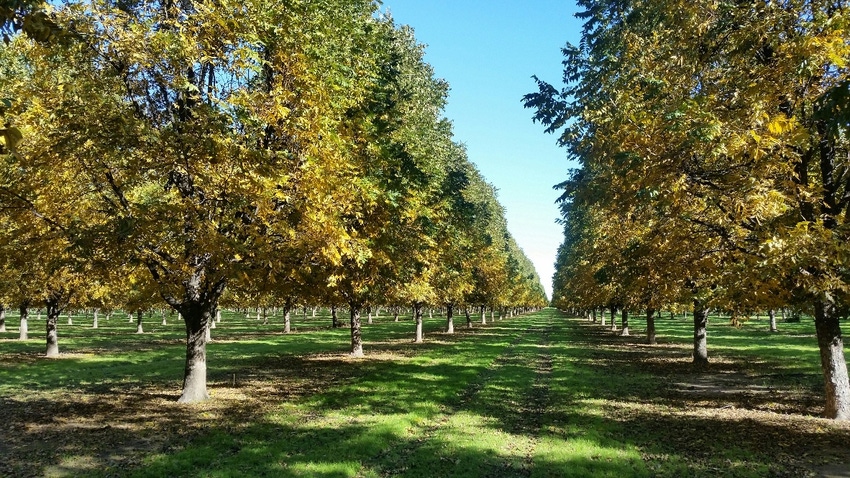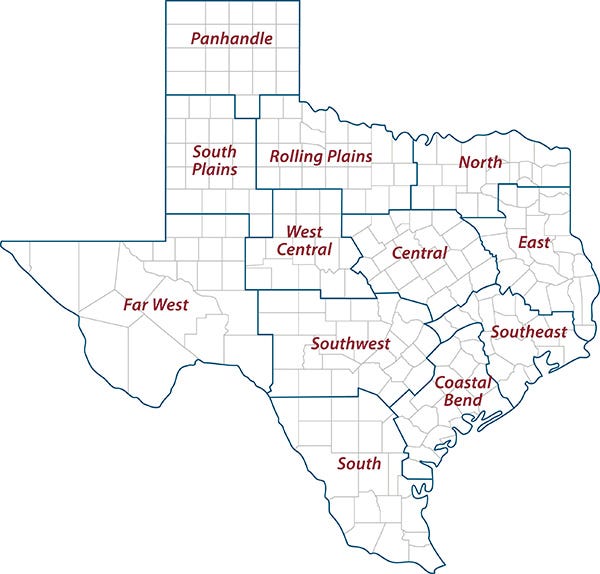
Texas pecan producers reported mixed crop expectations as they entered an important part of the growing season, said Horticulturist Larry Stein, Texas A&M AgriLife Extension, Uvalde.
The hit-or-miss crop is expected to produce average results overall, said Stein, though pecan quality is still yet to be decided as kernels fill.
“The pecan crop is up in the air right now,” he said. “But a lot of producers are saying they’re seeing a good crop, while others are considering whether they will even harvest.”
Some of the crop conditions this year are related to how individual growers fared in 2019, Stein said. Pecans can be a boom-and-bust crop, meaning exceptional growing seasons can be followed by a poor crop the following season.
But pecan orchard maintenance measures, such as stepping up fertilization, thinning the crop, and proper irrigation to reduce performance declines have improved tree recuperation. Stein said commercial producers typically assess their trees and manage them accordingly to avoid the boom-and-bust cycle.
The dramatic drop in temperatures last November damaged trees and caused premature leaf-drops that likely stunted crop performance in many areas, Stein said.
“You had temperatures go from 85 degrees to 19 degrees in some production areas, and that’s a dramatic shift,” he said. “We had 6-year-old trees killed, and the freeze likely caused more leaves to stop photosynthesis and storing up energy reserves for the winter. We typically say losing leaves before Thanksgiving is an indication that the following crop may not produce well.”
Pecan pests
Pecan growers should be assessing their potential crop now, Stein said, and making management decisions that will impact yields this year and next. Thinning trees with heavy clusters, irrigation and treating for shuckworms and weevils should be priorities.
Producers should be checking pecans to see if shells are hardening, which is an indication shuckworms could be a problem soon, he said.
“If you cut a cross-section of the nut and there is some resistance, they’re hardening, and it’s time to spray for shuckworms,” he said.
Weevils are another pest that can impact nut quality, Stein said. They typically emerge by mid-August when nuts enter the dough stage.
“If you cut the nut open and it’s started gelling, it’s time to spray,” he said. “If it’s still just water when you cut it open, it’s not quite time.”
Late-season irrigation
Water is a major contributor to quality from now to harvest, Stein said. Water feeds the kernel as it builds inside the shell.
Last year, quality was fairly good because production areas received timely rains, he said. Most commercial producers have irrigation, which is an important factor for producing retail-quality pecans.
Stein recommends 2 inches of water at and beyond the drip line per week.
“Late-season water is crucial to the kernel,” he said. “Quality sells, and you can’t sell them if there’s a mediocre fill.”
AgriLife Extension district reporters compiled the following summaries:

CENTRAL
Some trace amounts of rainfall were reported. Parts of the district reported good rain over the past 10 days. Flooding was reported in northern parts of the district. Early corn was being harvested for silage with fair yields reported. Temperatures were expected to reach beyond 100 degrees soon. Grain corn was almost ready to be harvested, and sorghum was almost all colored out. Producers were baling hay, and pastures were in good condition overall. Some pastures were showing signs of heat and drought stress. Livestock were in good condition. Irrigation was at maximum capacity on cotton. Nearly all counties reported short soil moisture levels.
ROLLING PLAINS
The district experienced a hot week, but some areas received up to 5 inches of rain. Pastures and improved grasses needed rain, and producers in drier counties expressed concerns about possible wildfires. Grasshoppers continued to be an issue.
COASTAL BEND
Weather continued to be hot and dry. Row crops were in fair to good condition. Corn and sorghum were being harvested with varying yields reported. The cotton crop was in full bloom and progressing well. Cotton irrigation continued where possible. Rice was heading out with some reports of harvest. Pastures and ranges were declining and needed rain. Some hay making took place. Livestock were doing well.
EAST
Some areas of the district received up to 9 inches of rainfall. Other areas remained dry. Pasture and rangeland conditions were good. Subsoil and topsoil conditions were adequate. Gregg County reported hay production continued with a third cutting. Producers continued to treat for weeds and insects. Grasshoppers and armyworms were reported. Horn fly numbers were high and caused problems. Wild pigs remained problematic. Local cattle markets were higher overall. Livestock were in good condition.
SOUTH PLAINS
Conditions were very hot and dry across the district. Most dryland cotton was in poor to fair condition. Irrigated cotton was in good condition. Corn was starting to silk. A few ranchers were planning to wean calves early due to limited grazing.
PANHANDLE
Crops and rangelands were suffering from 100-plus degree heat with moderate winds. Wells were struggling to keep up with irrigation needs. Northern, central and southwestern parts of the district reported very short to short topsoil and subsoil moisture levels. Southeastern areas reported short to adequate soil moisture levels. Pasture and rangeland conditions were very poor to fair. Corn was in fair to good condition. Cotton condition was mostly fair to poor. Sorghum was poor to fair. Peanuts were in poor to fair condition.
NORTH
Topsoil moisture levels ranged from short to very short. Rain fell across most of the district but amounts varied. Strong winds were reported. Pastures and hay meadows were still holding on, and crops looked good. Cattle were in good shape. Humidity caused light stress on livestock.
FAR WEST
Temperature highs were beyond 100-degrees with lows in the upper 70s. No precipitation was reported. Pasture and rangeland conditions were holding up for the most part though some pastures were completely bare. Grass fires occurred every day. Woody plants and succulents were the only green plants on some rangelands. Producers continued to feed livestock and wildlife. Livestock were in good condition overall. Pecan producers were irrigating and managing orchards. Most dryland crop acres that emerged had failed. Irrigated acres were making progress but showing moisture stress in the heat of the day. Insect activity was very low. Corn was finishing up with most all acres in the dent stage. Sorghum acres were blooming or in the dough stage, but many acres were stressed to the point that heads were not likely to produce. Watermelon harvest was in full swing.
WEST CENTRAL
No Report.
SOUTHEAST
Scattered rain was reported. Some areas were much drier than others, but pasture and forage conditions were generally holding well. Rangeland and pasture ratings were excellent to poor with good ratings being most common. Soil moisture levels ranged from adequate to very short with adequate levels being the most common.
SOUTHWEST
Pasture and rangeland conditions continued to decline with the lack of moisture and extreme heat. Irrigation was not keeping up with crop water demands. Sorghum harvesting should begin soon, and corn was denting. Hay was being stored. Livestock conditions remained fair to good with supplemental feeding. Cattle prices looked decent, and the sheep and goat market remained steady. Wildlife conditions were fair to good. Fawn sightings were high.
SOUTH
Weather was hot with adequate to very short soil moisture levels. Temperatures were at or above 100 degrees each day. Corn harvest began, and peanut fields were flowering or in the pegging stage. Cotton fields were setting bolls. Irrigation of cotton continued. Pasture and rangeland conditions continued to decline due to lack of rainfall and high temperatures. Sorghum harvest was underway with below-normal yields expected. Some sorghum fields showed multiple stages of development due to lack of moisture at planting. Crops like watermelons and cantaloupes were in full production. Producers were baling Coastal Bermuda grass pastures. Hay producers were fertilizing and watering pastures for additional cuttings. Livestock conditions improved the past two months. Starr County reported rangeland and pastures continued to improve. Zavala County reported extremely hot and dry conditions were taking a toll on native rangeland and pastures and forcing some producers to begin considering management practices to reduce grazing pressure. Some supplemental feeding was reported on smaller operations. Local beef cattle markets were steady with a slight increase in volume being offered. Cull cows were reported $2-3 less per hundredweight.
Source: is AgriLife TODAY, which is solely responsible for the information provided and is wholly owned by the source. Informa Business Media and all its subsidiaries are not responsible for any of the content contained in this information asset.
Read more about:
PecansAbout the Author(s)
You May Also Like




